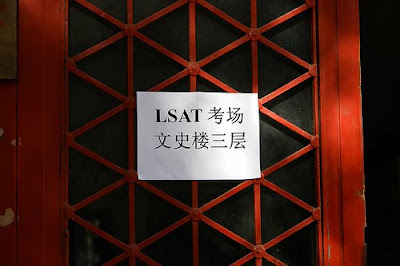 In this LSAT Blog post, I analyze two similar emails as if they were Logical Reasoning arguments. Both ended up in my spam folder (with good reason).
In this LSAT Blog post, I analyze two similar emails as if they were Logical Reasoning arguments. Both ended up in my spam folder (with good reason).Here's the first, edited for brevity:
It is understandable that you might be a little bit apprehensive because you do not know me, Please forgive this unusual manner to contact you, but this particular letter/email is of exceptional and private nature, as by virtue of my position in Hang Seng Bank - Hong Kong.
i have a lucrative business proposal of mutual interest to share with you. I will need you to assist me in executing a business project from our bank worth US$25.5 Million.
Here's the second, edited for brevity:
There is a sum of $19,500,000.00 in my bank Hang Seng Bank, Hong Kong. There were no beneficiaries stated concerning these funds which means no one would ever come to claim it. That is why I ask that we work together.I was excited about the first email until I got the second. The chances of getting two similar, yet unusual, proposals a day apart seemed highly unlikely, suggesting a scam.
I solicit for your assistance in effecting this transaction. I intend to give 30% of the total funds as compensation for your assistance. I will notify you on the full transaction and details of the transaction on receipt of your response if interested, And I shall send you the details and necessary procedures with which to make the transfer.
(Ok, I'm getting serious now. As much as I want to believe that you're just reading this blog for fun, you're probably reading it for help with your LSAT prep.)
Comparing the emails
After receiving both emails, I decided to compare the two since they make similar arguments.
Go back and read both, considering the strength of each argument as you read. Which makes a better case? Which email's argument is better-supported?
Basically, think about each email as if it were a Logical Reasoning stimulus.
First email
-The first part:
It is understandable that you might be a little bit apprehensive because you do not know me, Please forgive this unusual manner to contact youThis functions as a counterpremise. The spammer begins by acknowledging a weakness in the argument. Spammers understand most people are skeptical of anything in their spam mail folders. By pointing this out, the sender hopes to appear more legitimate. By pointing out that this is "unusual," the spammer tries to make us think that he isn't sending these kinds of emails all the time.
-The second part:
this particular letter/email is of exceptional and private nature, as by virtue of my vantage position in Hang Seng Bank - Hong Kong.The spammer begins to give evidence as to why he is sending this email. It's "exceptional" and "private." The fact that he has a position at the bank makes us more likely to believe the third part.
-The third part:
i have a lucrative business proposal of mutual interest to share with you. I will need you to assist me in executing a business project from our bank worth US$25.5 Million.The first sentence here isn't too important - it's basically just a background/filler sentence meant to get us interested. However, the second part pushes the envelope. Saying "I will need you to assist me" struck me as an unsupported conclusion. The author (spammer) offers no evidence as to why he needs me in particular. What special qualifications do I hold? Why can't the spammer carry out this "business project" on his own?
One principle that would justify this argument is:
If someone has a "vantage position" in a bank, then he will be incapable of executing a business project on his own and will require the assistance of the LSAT tutor who runs LSAT Blog to carry out said business project.
Second email
-The first part:
There is a sum of $19,500,000.00 in my bank Hang Seng Bank, Hong Kong. There were no beneficiaries stated concerning these funds which means no one would ever come to claim it. That is why I ask that we work together.By itself, the first sentence is background. However, when combined with the 30% figure mentioned later in the stimulus, this becomes a reason (evidence) for me to work with the spammer.
We can rephrase second sentence to read, "Because there were no beneficiaries...no one would ever come to claim it."
"No beneficiaries" serves as evidence for the subconclusion that "no one would ever come to claim it." Then, "no one would ever come to claim it" serves as evidence for the main conclusion that we should work together.
-The second part:
I solicit for your assistance in effecting this transaction.This is the conclusion. It's a restatement of the previous sentence asking we work together. Just like real LSAT Logical Reasoning stimuli and Reading Comp passages, sometimes the author is redundant.
-The third part:
I intend to give 30% of the total funds as compensation for your assistance. I will notify you on the full transaction and details of the transaction on receipt of your response if interested, And I shall send you the details and necessary procedures with which to make the transfer.The 30% figure is giving a reason to engage in the deal, but the rest is just housekeeping (organizational) stuff. Nothing special.
***
So, which email makes a better argument?
First email
I like that it used a counterpremise. It helped to ease my concerns.
The fact that the spammer has a position in the bank seems pretty promising.
However, this spammer made a serious unsupported claim that he needed me specifically to carry out the project. The spammer didn't provide any evidence to support this.
Second email
I enjoyed the evidence -> subconclusion -> main conclusion format. It was very smooth and logical, and a lot clearer than some Logical Reasoning stimuli.
I also liked that this spammer didn't make any big unsupported conclusions. However, I was disappointed that this scam only involved $19.5 million, of which I'd get a measly 30%.
The 1st email involved $25.5 million. Although that one didn't say what percentage I'd get, it's got me expecting a larger sum for my participation in any international banking scams.
The Verdict
I've decided not to participate in either scam, but I'm keeping my eyes peeled.
I'm sending both spammers a link to this blog post in the hopes it'll help them make better arguments the future.
(If you need to reach the spammers, email #1 is from jonchochan@hangseng.com, and email #2 is from songlile@jw.liyang.gov.cn)
See fun facts about the spam industry.
***
Please join me in thanking the spammers for the supplying raw material for this week's blog post.
Photo by foolswisdom / CC BY-NC 2.0


























